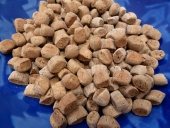Hey Leonora! There indeed is a lot out there in terms of conflicting opinions.
Inge Leonora-den Ouden wrote:
1. they all use white wheat flour. I want whole rye bread.
2. they all use different (large) quantities. I only need one small loaf of rye bread a week.
3. they all throw away most of their sourdough starter every day. I don't want to waste good food ingredients.
4. they say the right temperature for the starter is between 21 and 25 degrees Celsius (most of the time they say it in Fahrenheit: 70-77). My room temperature is lower. There is no place in the house with a higher temperature. Will this work???
1. while I know people use various other flours for their starters, it seems to be more reliable with white (or rye) flour to get the starter going. Of course, you can use that starter to make any kind of bread.
2. I scaled my starter down to fit into a ~400ml jar, which I keep about half full. This gives me about a cup of starter to use in recipes and a bit to keep the starter going. There's no reason you can't do that!
3. during the starter development stage you're trying to coax the starter into existence, and you have a week or so of lots of discard, it's true. It troubles me too: flour is expensive now. save what you scoop out in the fridge: we have at least one good thread about ideas for using leftover starter. In my house it becomes waffles, cornbread, or lunchy flatbreads. But if you use it only once a week you should be able to get on a weekly schedule- you mix up your dough on Monday, so on Saturday you freshen your starter, maybe.
4. In the winter I have the same issue, cold house, but I find that is important really only in the beginning when you're growing the starter (in that case I'd keep it wherever there is warmth from electronics (near the back of my fridge) or worst case scenario, in a cooler box or oven with a hot water bottle. It can live just fine in cooler temps (my sourdough lives in the fridge for most of the year when our inside temp exceeds 18C-ish or else I have to feed it every day, and this year it was forgotten during the winter for 2 months and lived there all year round...).
There is so much variation in advice because it's very permie: lots of variables. You can totally do one small loaf a week with a small volume of starter, and you can start with rye, or shift to rye, or use white flour starter in rye.
I find the videos and instructions online are much more helpful for addressing problems (why didn't my loaf rise nicely, how to handle the loaves, etc) than for starting from zero: too much noise out there!










